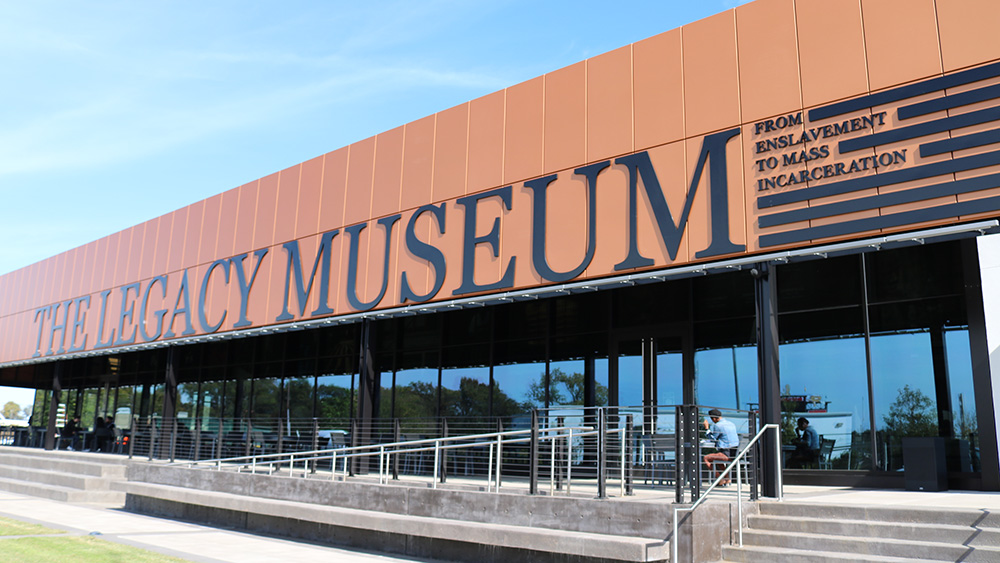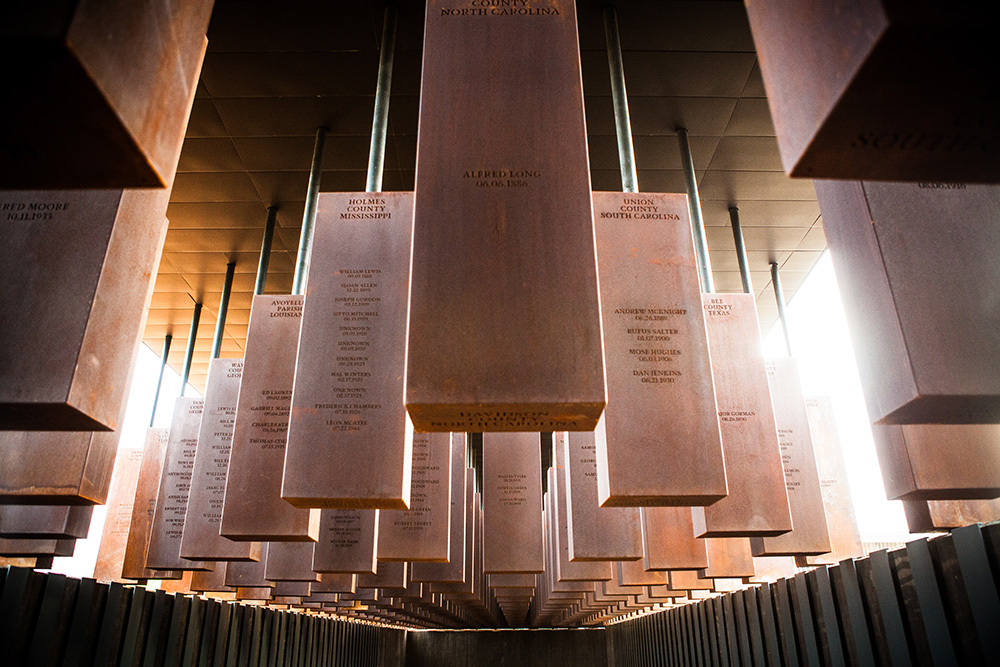
Participants of this year’s Big Life Series event reenact the beginning of the history-making Selma to Montgomery march on the Edmund Pettus Bridge. (Travis Ellison photo)
Over the last two years, more than 300 student athletes, coaches, and college administrators have traveled from across the U.S. to Montgomery, Alabama, to immerse themselves in the history of the modern Civil Rights Movement.
The two-day “Big Life Series” — first held in 2022 and repeated last summer — is produced by the Big Ten Conference, the oldest Division I collegiate athletic conference in the U.S. It’s a project of the conference’s Equality Coalition, which was founded in the summer of 2020 in the aftermath of George Floyd’s murder, with the goal of educating and engaging student athletes and serving as a vehicle for what then-Big Ten Commissioner Kevin Warren called “much-needed dialogue” about the “issues that have impacted race relations for many years.”
The plan for the inaugural event in 2022 had been to base the event in Selma, Alabama — the starting point for a series of pivotal civil rights marches in the spring of 1965, including on March 7, when state and local police brutally attacked a group of about 600 people who set out to walk to the state Capitol in Montgomery to protest the denial of voting rights to Black citizens. That evening, on what came to be called “Bloody Sunday,” televised images of officers tear-gassing the crowd and whipping and beating protesters with clubs on the Edmund Pettus Bridge in Selma shocked and galvanized the nation. Less than six months later, Congress passed the Voting Rights Act of 1965.
While Selma plays an outsized role in the history of civil rights, the city itself is small, without a hotel large enough to accommodate the Big Life participants. Omar Brown, the Big Ten’s senior vice president, community and impact, and the director of the Big Life event, and his colleagues turned their attention to nearby Montgomery. There they met with Ronald Simmons, IOM, chief officer, destination and community development for Experience Montgomery, the city’s CVB, and Ashley Brandle-Jernigan, a former corporate planner and founder of JDB Hospitality, a brand management firm for the hotel industry. That meeting, Brown said, “blew the trip open.”
With more than 7,000 hotel room nights available, Montgomery easily had the infrastructure to support the event, but more important, Brown said, was the weekend-long itinerary that Jernigan, who is a consultant for Experience Montgomery, created for the group. It was “the most action-packed 48 hours imaginable,” Brown said, filled with visits to museums and historic sites, firsthand accounts from individuals who participated in Selma marches six decades ago, and memorable meals, including a dinner featuring such Southern staples as fried chicken, collard greens, and candied yams.
A high point for Brown came on Saturday, when participants traveled by bus from Montgomery to Selma, where they visited the 125-year-old red-brick First Baptist Church, used during the civil rights campaign as the headquarters for student organizers. At the church, Selma resident Lynda Blackmon Lowery, who was 15 in 1965 and the youngest person to make the 54-mile-long march from Selma to Montgomery, spoke to the group. “We’re in this historic church,” Brown said, “and we had a choir — that took it up a notch. And then we got outside, and we started marching.”
On the bridge, Brown, who was shepherding participants, lost his voice, and a student athlete asked him for his bullhorn. “Not only did she take the bullhorn, she led the march,” Brown said. “And so now we had student athletes leading the march, not me, not [Warren] the commissioner. She was out front leading us and taking us on the march.”

The Legacy Museum in downtown Montgomery tells 400 years of Black American history. (Courtesy of Experience Montgomery)
Designed for Impact
But the “crown jewel” of the trip, Brown said, was their visit to the Legacy Museum in downtown Montgomery, where 400 years of Black American history, from slavery to Jim Crow laws and racial segregation, lynching, the Civil Rights Movement, and mass incarceration, is told through interactive exhibits, first-person historical accounts, and art. The Legacy Museum, which opened in 2018 and was expanded in 2021, is an educational project of the Equal Justice Institute (EJI), a nonprofit founded in 1989 in Montgomery by lawyer Bryan Stevenson, known for his work representing death-row inmates and author of the memoir Just Mercy. According to the EJI website, seeing firsthand “how excessive punishment, racial discrimination, and inequality are deeply rooted in America’s history of racial injustice” inspired EJI to raise $20 million in private funds to build the Legacy Museum and a companion site, the National Memorial for Peace and Justice, which remembers more than 4,400 Black people killed by lynching between 1877 and 1950.
“What I’m encouraged by is that we’ve had hundreds of thousands of people come to the site since we opened in 2018. And most of them say, ‘I didn’t know this,’” Stevenson told NPR after the museum’s expansion in 2021. “I don’t want to talk about slavery and lynching and segregation because I want to punish America. I want us to get to a better place.”
First-time visitors may be unaware how deeply Montgomery has reckoned with its history, Jernigan said. “When you’re trying to have a conversation and you’re trying to understand racial tension … you can come to Montgomery and understand the basis,” she said. “You can begin to have conversations you may not have had before, because maybe you didn’t know that level of truth that Montgomery has embraced — and that Montgomery has now pushed out into the world to say: ‘This is who we are. Let’s have these conversations and let’s create a safe space for you to have these conversations, to ensure that history doesn’t repeat itself.’”
As the “spark of the modern Civil Rights Movement,” the area is experiencing increased interest from meeting organizers, Jernigan said, particularly those interested in diversity, equity, and inclusion efforts. In late October, the National Association for Public Defense held its 4th annual Racial Justice Conference in Montgomery, which included visits to the Legacy Museum and the Memorial in its program.
But conferences happen all the time in Montgomery, Simmons said, and corporate and association meetings increasingly use the city’s museum spaces for breakout sessions, as well as for receptions and special events. Using the city’s “backdrop of history,” Simmons said, “we can curate those after-hours experiences for them that are different from anywhere else.” The point of spaces like the Legacy Museum isn’t to bring visitors in to look at artifacts, he added. “They’re designed to impact lives.”

One of the stops during the Big Life Series event was the National Memorial for Peace and Justice in Montgomery, (Courtesy of Experience Montgomery)
An Overnight Change
Montgomery has always been the birthplace of the modern Civil Rights Movement — “that history has always been here,” said Experience Montgomery’s Ronald Simmons. But the 2018 opening of the Equal Justice Initiative’s (EJI) Legacy Museum and the National Memorial for Peace and Justice — which draw a reported 40,000 visitors a month — changed the city as a destination “literally overnight,” he said. A third EJI site, a 17-acre Freedom Monument Sculpture Park,is scheduled to open in 2024.
The influx of visitors, many of them international, has brought new hotels and new meeting spaces to the city. In 2020, EJI added a Legacy Pavilion in downtown Montgomery, with three meeting spaces, as well as Legacy Plaza, an outdoor space designed as a place to gather for informal conversations.
It also brings new opportunities for the city to tell its own stories, Simmons said. Visitors are coming to the EJI sites, “and the great part is, they also are experiencing everything else we have to offer — like the Rosa Parks Museum and the Selma to Montgomery experience and that story,” he said. “And they’re experiencing the new Montgomery, where we are headed and where we are now.”
Barbara Palmer is deputy editor of Convene.
